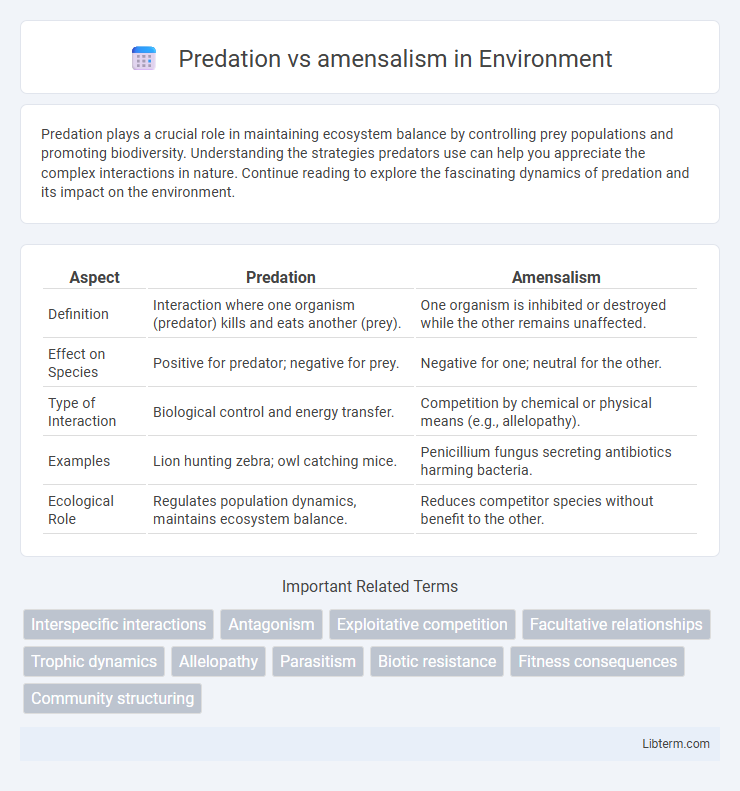Predation plays a crucial role in maintaining ecosystem balance by controlling prey populations and promoting biodiversity. Understanding the strategies predators use can help you appreciate the complex interactions in nature. Continue reading to explore the fascinating dynamics of predation and its impact on the environment.
Table of Comparison
| Aspect | Predation | Amensalism |
|---|---|---|
| Definition | Interaction where one organism (predator) kills and eats another (prey). | One organism is inhibited or destroyed while the other remains unaffected. |
| Effect on Species | Positive for predator; negative for prey. | Negative for one; neutral for the other. |
| Type of Interaction | Biological control and energy transfer. | Competition by chemical or physical means (e.g., allelopathy). |
| Examples | Lion hunting zebra; owl catching mice. | Penicillium fungus secreting antibiotics harming bacteria. |
| Ecological Role | Regulates population dynamics, maintains ecosystem balance. | Reduces competitor species without benefit to the other. |
Introduction to Ecological Interactions
Predation and amensalism are key ecological interactions that shape community dynamics and biodiversity. Predation involves one organism, the predator, feeding on another, the prey, directly impacting population control and energy flow in ecosystems. Amensalism describes a relationship where one species is inhibited or harmed while the other remains unaffected, often influencing species distribution and resource competition without reciprocal effects.
Defining Predation
Predation is a biological interaction where one organism, the predator, hunts, kills, and consumes another organism, the prey, directly influencing population dynamics and energy flow within ecosystems. This form of interaction is characterized by the predator benefiting at the expense of the prey, often leading to evolutionary adaptations such as camouflage, speed, or defensive mechanisms in prey species. Predation differs from amensalism, where one species is inhibited or destroyed while the other remains unaffected, with predation involving active consumption and amensalism involving passive suppression.
Understanding Amensalism
Amensalism is an ecological interaction where one species is inhibited or harmed while the other remains unaffected, contrasting with predation where one species benefits by consuming the other. This type of relationship often occurs through the release of chemical substances, such as antibiotics produced by fungi or plants, that suppress the growth of competing organisms. Understanding amensalism highlights its role in shaping community structure and maintaining ecological balance without direct resource consumption.
Key Differences Between Predation and Amensalism
Predation involves one organism, the predator, actively hunting and killing another organism, the prey, for sustenance, whereas amensalism occurs when one organism is inhibited or destroyed while the other remains unaffected, often through the release of toxins. In predation, there is a clear benefit to the predator and harm to the prey, but in amensalism, only one species experiences a negative impact without any reciprocal benefit or harm. Predation is a direct biological interaction influencing population dynamics, while amensalism typically represents an indirect impact arising from environmental or chemical factors.
Ecological Roles of Predators
Predators play a crucial ecological role by regulating prey populations, which helps maintain ecosystem balance and biodiversity. Through selective feeding, predators prevent prey overpopulation and resource depletion, supporting habitat stability and nutrient cycling. Their presence also drives evolutionary adaptations, influencing species diversity and community dynamics.
Examples of Predation in Nature
Predation involves one organism, the predator, actively hunting and consuming another, the prey, such as lions hunting zebras or owls capturing mice. In contrast, amensalism occurs when one species is inhibited or destroyed while the other remains unaffected, exemplified by the black walnut tree releasing juglone toxin that harms nearby plants without gaining direct benefit. Predatory interactions play a crucial role in regulating population dynamics and maintaining ecosystem balance, unlike amensalism, which primarily influences species distribution.
Amensalism in Ecosystems: Real-World Cases
Amensalism occurs when one species is inhibited or destroyed while the other remains unaffected, commonly seen in ecosystems where large plants release chemicals toxic to smaller plants or microorganisms. Black walnut trees (Juglans nigra) exemplify amensalism by secreting juglone, a compound that suppresses the growth of nearby vegetation, impacting plant diversity in temperate forests. This antagonistic interaction contrasts with predation, where one organism benefits by consuming another, highlighting amensalism's subtle but significant role in shaping community structure and species composition.
Evolutionary Impact of Predation and Amensalism
Predation drives evolutionary adaptations by exerting selective pressure that leads to the development of defensive mechanisms, camouflage, and enhanced sensory abilities in prey species. Amensalism, while less directly impactful on evolutionary pathways, influences community structure by suppressing certain species through chemical or physical means, indirectly shaping species interactions and resource distribution. The differential evolutionary impacts highlight predation as a dynamic force promoting coevolution, whereas amensalism primarily affects ecological balance and species diversity.
Effects on Biodiversity and Community Structure
Predation directly influences biodiversity by regulating prey populations and promoting species diversity through natural selection, often leading to a balanced community structure. Amensalism negatively impacts biodiversity by inhibiting or destroying certain species without any benefit to the inhibitor, potentially reducing species richness and altering community composition. These interactions shape ecosystem dynamics differently, with predation fostering dynamic stability, while amensalism can contribute to decreased diversity and dominance by unaffected species.
Conclusion: Predation vs Amensalism in Ecology
Predation involves one organism benefiting by consuming another, directly impacting population dynamics and promoting evolutionary adaptations. Amensalism, characterized by one species suffering harm while the other remains unaffected, influences community structure without reciprocal interaction. Understanding the distinct ecological roles of predation and amensalism reveals their contrasting effects on biodiversity and ecosystem stability.
Predation Infographic

 libterm.com
libterm.com